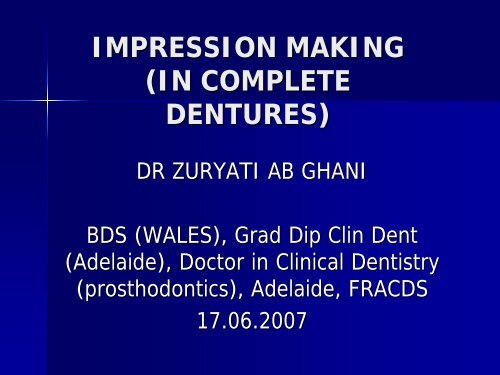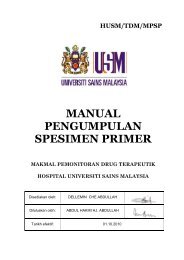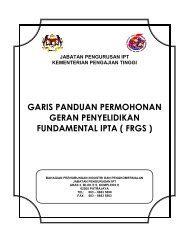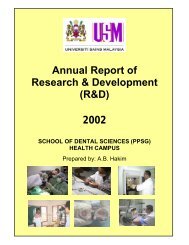Impressions
Impressions
Impressions
You also want an ePaper? Increase the reach of your titles
YUMPU automatically turns print PDFs into web optimized ePapers that Google loves.
IMPRESSION MAKING<br />
(IN COMPLETE<br />
DENTURES)<br />
DR ZURYATI AB GHANI<br />
BDS (WALES), Grad Dip Clin Dent<br />
(Adelaide), Doctor in Clinical Dentistry<br />
(prosthodontics), Adelaide, FRACDS<br />
17.06.2007
<strong>Impressions</strong><br />
• An impression – an imprint produced<br />
by ‘the pressure of one thing upon or<br />
into the surface of another’<br />
• Active rather than passive role<br />
• Making rather than taking<br />
• Flawed impressions account for the<br />
majority of denture problems
Categories<br />
• Primary impressions<br />
• Conventional techniques<br />
• Template techniques<br />
• Definitive/secondary impressions<br />
• Conventional techniques<br />
• Selective pressure techniques<br />
• Functional techniques<br />
• Reline and rebases techniques
PRIMARY IMPRESSION<br />
• Definition-an impression made for the purpose<br />
of diagnosis or for the construction of a tray
Tray selection for primary<br />
inpression<br />
• stock trays (for edentulous ridge)<br />
• metal or plastic, perforated or non<br />
perforated<br />
• 2-33 mm clearance between stock<br />
tray and ridge<br />
• tray should extend over tuberosity<br />
and hamular notch
Materials for primary<br />
impression<br />
• Relatively high viscosity materials<br />
• Alginate – used with perforated trays<br />
(metal or plastic)<br />
• Compound – used in with non<br />
perforated trays
Primary impression<br />
• Upper<br />
Sit patient upright<br />
‣ Stand on one side and behind the patient (Your elbows<br />
level with patient’s s upper jaw)<br />
‣ Evert upper lip<br />
‣ Hold the loaded tray inferior and anterior to the incisive<br />
papilla<br />
‣ Insert the tray upwards and backwards to fill, first of all,<br />
the labial sulcus, , then left and right sulci before the palatal<br />
area is pressed into position<br />
‣ Ensure the material record the right and left sulci<br />
‣ Borders definition- ask pt to suck down into tray, move<br />
mandible side to side and then open wide.
Primary impression<br />
• Lower<br />
Sit patient upright with your elbows level with<br />
patient’s s lower jaw.<br />
‣ Stand to one side and in front of the patient<br />
‣ Rotate the tray within the pt’s s mouth in a<br />
horizontal plane until it is in the center of<br />
residual ridge and press the loaded tray<br />
‣ The labial, right and left sulci in turn being<br />
everted to permit the impression material to fill<br />
the functional width of the sulci<br />
‣ ask pt to raise tongue, then border mould.
• Once the material has set, the tray is<br />
removed in one motion<br />
• Mark the borders of the custom tray to<br />
be made.<br />
• Pour up impression
Secondary or definitive<br />
impression<br />
• Definition<br />
‣ Should record the entire functional denture-<br />
bearing area to ensure maximum support,<br />
retention and stability for the denture during use<br />
• Primary purpose<br />
‣ To record accurately the tissues of the denture<br />
bearing areas, in addition to recording the<br />
functional width and depth of the sulci
Special trays<br />
• Close fitting tray<br />
• 2mm even thickness<br />
• Smooth<br />
• Rigid material ( eg. Cold cure acrylic)<br />
• 2mm short of sulcus<br />
• 45° handle
2°impression (Conventional<br />
technique)<br />
• Disinfect the trays<br />
• Check for adequate extension (antero-<br />
posteriorly and bucco-lingually)<br />
• Use pressure indicating paste<br />
• Correct under extension with tracing compound<br />
• Trim the tray if over extended<br />
• Apply tracing compound to the posterior<br />
aspect of the upper tray to produce a<br />
posterior seal
Secondary impression<br />
making<br />
• Upper and lower arches- follow<br />
primary impression taking<br />
• Materials – Zinc oxide eugenol<br />
(material of choice)<br />
- Polyether<br />
- Polyvinylsiloxane (PVS)
Anatomical landmarks of<br />
importance<br />
• Upper arch<br />
• Lower arch
Salient anatomical features of<br />
denture bearing areas
The Incisive Papilla<br />
• Soft tissue pad<br />
• Covering the incisive canal
The Incisive Papilla<br />
• Nerves and blood vessels supplying<br />
the anterior part of the palatal mucosa<br />
• Position – relatively constant following<br />
the extraction of the natural teeth<br />
• Useful guide when placing artificial<br />
teeth as the labial surface of the upper<br />
anterior teeth is usually 8-10mm 8 10mm in<br />
front of the centre of the papilla
Palatine Fovea/fovea<br />
Palatinae<br />
• Two orifices (small depressions in the<br />
mucosal surface) one each side of the<br />
midline<br />
• About 2mm posterior to the vibrating<br />
line<br />
• Act as collecting ducts for a group of<br />
minor palatine salivary glands
Vibrating Line<br />
• Imaginary line across the posterior part of<br />
the palate marking the division between the<br />
movable and immovable tissues of the soft<br />
palate<br />
• Junction of the hard and soft palate<br />
• This line should lie in the soft palate<br />
• The posterior border of the denture usually<br />
finishes on the compressible tissue 1-2mm 1<br />
posterior to the vibrating line. It must cover<br />
to the tuberosities and extend to the<br />
hamular notches.
Freanum<br />
• A narrow fibrous submucosal<br />
membrane bridging the buccal, , labial,<br />
or lingual sulcus<br />
• This picture shows an upper<br />
impression with a depression created<br />
by a buccal freanum
Retromolar Pad<br />
• Triangular soft tissue elevation distal to<br />
the third molars<br />
• Important for denture support and<br />
preventing distal denture displacement<br />
• Bounded by tendons and raphes of<br />
muscles.<br />
• Denture base should extend only one<br />
half to two third of the retromolar pad
THANK YOU<br />
Some of the materials are<br />
courtesy of Dr Adam<br />
Husein
References<br />
1. Nallaswamy D. (2003). Textbook<br />
of Prosthodontics. Jaypee brothers<br />
medical publishers (p) LTD. New Delhi<br />
2. Some illustration are courtesy Dr<br />
Adam Husein

















